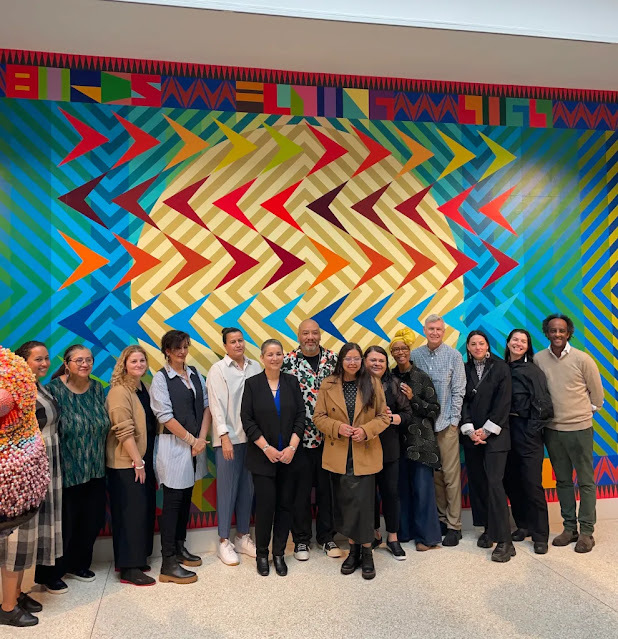 |
A Swell of Native Pride at Jeffrey Gibson’s Venice Symposium
By
11/5/2024 hyperallergic.com /963410/a-swell-of-native-pride-at-jeffrey-gibson-venice-symposium/
VENICE, ITALY — The air was full of energy outside Jeffrey Gibson’s (Mississippi Choctaw/Cherokee) United States Pavilion at the Venice Biennale on October 26, after White People Killed Them finished their performance. Raven Chacon (Diné) played a keyboard synth, pitch shifter, and distortion pedals, as well as vocalized and used a loop cassette player, while John Dieterich played the electric guitar at the base of Gibson’s bright-red sculpture comprising empty plinths and pedestals titled “the space in which to place me,”sharing a name with the exhibition itself. Marshall Trammell played a drumset on top of the interactive sculpture’s front pedestal, performing with such passion that his bass drum kept sliding toward the edge of the pedestal. Near the end of the performance, Gibson rose from his seat in the audience and retied a cement block placed on the base of the drum to prevent it from crashing down. Afterward, several Native curators, artists, and scholars confided that they felt their insides vibrate from the sheer volume of the electronic music.
This was the last performance of if I read you/what I wrote bear/in mind I wrote it, a three-day convening hosted by Bard College’s Center for Indigenous Studies to “address the interdisciplinary, transnational nature of Jeffrey Gibson’s work in the US Pavilion.” Before White People Killed Them took the stage, members of the Colorado Inter-Tribal Dancers and Oklahoma Fancy Dancers welcomed the large crowd gathered around the pavilion and performed to hand drumming and singing by Miwese Greenwood (Otoe-Missouria-Chickasaw-Ponca). At the beginning of the blended performance, dancer Kevin Connywerdy (Kiowa and Comanche) told the audience that Gibson’s presence at the pavilion was not only an honor for the artist himself but for “all of our people.”
Nick Ohitika Najin (Cheyenne River Sioux) from the Colorado Inter-Tribal Dancers joins the performance by White People Killed Them.
As a Diné audience member who spent the previous three days at the convening, I shared Connywerdy’s sentiment of Native pride. It was stunning to witness the various performers making the sculpture their stage, with dancers surrounding it in brightly colored regalia that matched the color of Gibson’s block text across the top of the pavilion that read “THE SPACE IN WHICH TO PLACE ME” and “WE HOLD THESE TRUTHS TO BE SELF EVIDENT.” As Greenwood’s drum echoed, it was not only heard but deeply felt.
This specific feeling of a hand drum’s echo is found across the United States at Native cultural events, powwows, and performances. And in accordance with the spirit of Native humor at those events, Connywerdy jokingly told the audience to get ready to hear some Grateful Dead when he introduced White People Killed Them. In the middle of the performance, Nick Ohitika Najin (Cheyenne River Sioux) from the Colorado Inter-Tribal Dancers seamed the two separate performances. The crowd cheered as he rejoined the sculpture-stage and danced around the trio. The bells on his regalia joined Trammell’s drum beat. While Chacon’s fingers quickly moved around the keyboard synth, Ohitika Najin waved his feather fan around the keyboard. This fusion of radically different styles was representative of the convening, which gathered Native and non-Native poets, academics, artists, musicians, curators, teachers, and students. The convening as a whole felt like an energizing disco, a kaleidoscopic exploration of Native identities in all their rich dualities, contrasts, and dichotomies: familiar and unfamiliar, past and future, joy and sorrow, detailed and monumental.
“I think one of the goals was for people to understand how many different tribal nations there are, how many different cultural contexts there are, and how many different languages there are,” he continued. “My hope is that we’ve been able to push some of those conversations to the next subject or the next place.”
KEEP READING: hyperallergic.com /963410/a-swell-of-native-pride-at-jeffrey-gibson-venice-symposium/
|
John Dieterich on guitar, Marshall Trammell on drums, and Raven Chacon (Diné) on keyboard synth, pitch shifter, and distortion pedals |








No comments:
Post a Comment
Please leave a comment.